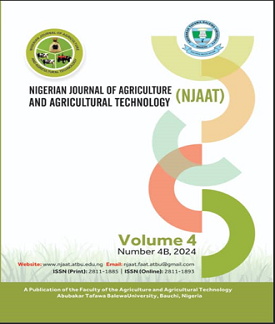ANALYSIS OF FARM LABOUR UTILIZATION IN DRY SEASON MAIZE PRODUCTION IN SELECTED LOCATIONS IN KADUNA METROPOLIS, KADUNA STATE, NIGERIA.
DOI:
https://doi.org/10.59331/njaat.v4i4B.915Keywords:
Farm, Labour, Underutilization, OverutilizationAbstract
This study examined farm labour utilization in dry season maize production in kaduna metropolis, Kaduna State Nigeria. Purposive and random sampling technique was used in selecting 60 respondents. Primary data were collected using structured questionnaire and analyzed using production function analysis. Results revealed that majority (50.00%) of the farmers are in the age bracket of 36 - 40 year of age; 75.00% were married; 50.00% had no formal education; 58.30% of the respondents had family size of between 6 – 10 persons; 46.67% realized income of between
N301,000.00 to N350,000. The regression analysis shows linear function as the lead equation with an R2 of 0.771, adjusted (R2) of 0.754 implying that over 75% the variation in the output of dry season is explained by the independent variables included in the model. Result also revealed that the resources were inefficiently utilized, particularly farm size, family labour with allocative efficiency index of 0.728 and 0.717 respectively signifying overutilization. Furthermore, capital inputs had index value of 3,735 indicating underutilization, all in an attempt to optimize production goals. The study concludes that dry season maize farmers were not efficient in farm labour utilization. It is recommended that farmers be encouraged to expand their farm size so as to absorb the surplus family labour supply.
Downloads
Downloads
Published
How to Cite
Issue
Section
License
Copyright (c) 2024 Nigerian Journal of Agriculture and Agricultural Technology

This work is licensed under a Creative Commons Attribution-NonCommercial-ShareAlike 4.0 International License.
This work is licensed under a CC Attribution-NonCommercial-ShareAlike 4.0







